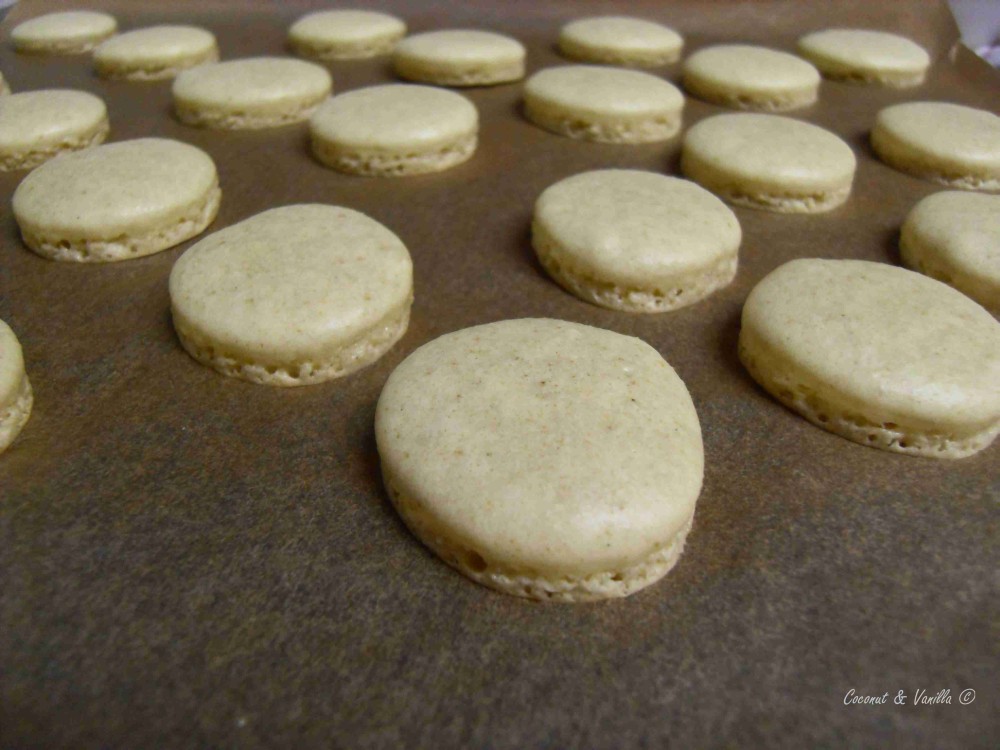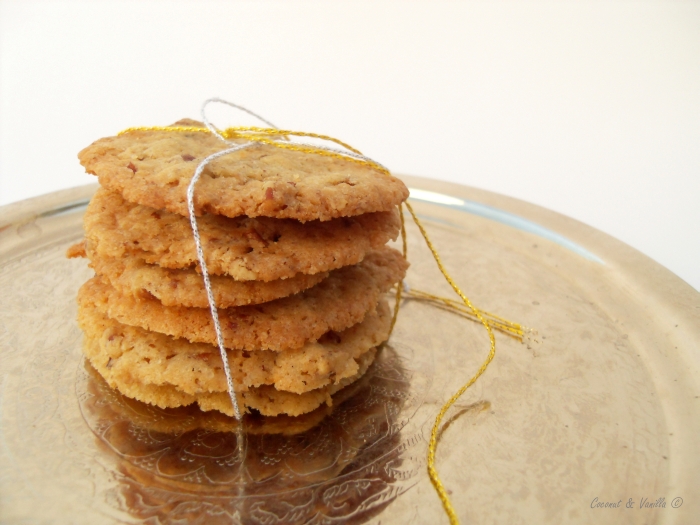Update: Für das deutsche Rezept nach unten scrollen!
This month challenge for the Daring Bakers were French Macarons. The 2009 October Daring Bakers’ challenge was brought to us by Ami S. She chose macarons from Claudia Fleming’s The Last Course: The Desserts of Gramercy Tavern as the challenge recipe.

I was a bit scared, because I tried macarons some weeks ago the first time and they went totally wrong. The shells weren’t really hard, almost no „feet“ (you can see feet in the picture of my succesful anis macarons below) and they were much too soft. But I was also eager to do it better.
In the (english) food blog world everyone is about macarons. But here in Germany nobody knows them. Or precisely macarons are known as something different. Dessicated coconut with beaten egg whites and sometimes nuts or chocolate within. „Feets“ are not wanted, it’s more like small piles. Germans wake up and get to know french macarons!
The challenge itself was challenging. After my first mishappening and reading in the Daring Bakers Forum about the problems with the recipe given and the better-going recipes with Tartelette’s one, I decided to give the disaster not a chance again and go with Tartelette’s recipe.
The recipe is very easy to vary. I made the Cinnamon Macarons with hazelnuts and a Tbsp. cinnamon and a gianduja (rounded up with some cream) filling and the Anise Macarons with almonds a Tbsp. grounded anise and a white chocolate filling.

Some tips, which I found important are:
Ground your grounded nuts again yourself (something like a Moulinette would be helpful). They are not fine enough. Sieve your powdered sugar before.
I used a silicone mat and normal parchment paper and I would prefer the parchment paper here, because the macarons sticked so much to my silicone mat, I didn’t get them off right. Also after baking let them cool for about 15 minutes outside, then move the baking sheet back in the warm (but not hot!) oven. Let them cool completely over the night. Mine were mostly *fingers crossed* easy to peel off the parchment paper. If it doesn’t work give some sprinkles of water under the paper, if the sheet is still warm or hold it over some steaming water. The steam dissolves the macarons from the paper.
For piping: stand your bag up in a high glass. It’s easier for filling and when you rest.
In my opinion the macarons are the better the smaller they are. Furthermore the ywill expand a little while baking. Hope all this helps. If you have any questions feel free to ask! This is how my macarons looked like after piping, while drying, before baking.

Französische Macarons
von Tartelette
Zutaten:
- 90 g Eiweiß (etwa 3)
- 30 g Zucker
- 200 g Puderzucker
- 110 g gemahlene Mandeln (Mandelmehl wäre optimal)
Am Tag davor (24 h) die Eier trennen und die Eiweiße abgedeckt bei Raumtemperatur aufbewahren. Man kann auch Eiweiß aus dem Kühlschrank benutzen, dann sollten die Eier aber bereits mehr als 48 h getrennt sein.
Die Eiweiße steif schlagen und nach und nach den Zucker zugeben und weiterschlagen, bis man einen glänzenden Meringue hat. Nicht zu lange schlagen, damit der Meringue nicht zu trocken wird.
Die Mandeln mit dem Puderzucker in eine Küchenmaschine oder einen Blitzhacker geben und mahlen bis die Nüsse sehr fein sind (bei Mandelmehl nicht nötig). Zum Meringue geben und vorsichtig unterheben, dabei erst ein paar schnelle Züge, gefolgt von langsameren Unterheben. Man sollte nicht mehr als 50 Züge benötigen.
Einen Spritzbeutel mit einer runden Tülle (Kaiser 9 mm Größe 3) ausstatten, mit dem Teig befüllen und 3 cm große Kreise auf das Backpapier spritzen.
Die Macarons 30-60 Minuten stehen lassen, damit sie außen antrocknen. Das ist wichtig, damit nachher „Füßchen“ enstehen.
Den Ofen auf 140° C vorheizen.
15-20 Minuten backen. Auskühlen lassen.
This month challenge for the Daring Bakers were French Macarons. The 2009 October Daring Bakers’ challenge was brought to us by Ami S. She chose macarons from Claudia Fleming’s The Last Course: The Desserts of Gramercy Tavern as the challenge recipe.

I was a bit scared, because I tried macarons some weeks ago the first time and they went totally wrong. The shells weren’t really hard, almost no „feet“ (you can see feet in the picture of my succesful anis macarons below) and they were much too soft. But I was also eager to do it better.
In the (english) food blog world everyone is about macarons. But here in Germany nobody knows them. Or precisely macarons are known as something different. Dessicated coconut with beaten egg whites and sometimes nuts or chocolate within. „Feets“ are not wanted, it’s more like small piles. Germans wake up and get to know french macarons!
The challenge itself was challenging. After my first mishappening and reading in the Daring Bakers Forum about the problems with the recipe given and the better-going recipes with Tartelette’s one, I decided to give the disaster not a chance again and go with Tartelette’s recipe.
The recipe is very easy to vary. I made the Cinnamon Macarons with hazelnuts and a Tbsp. cinnamon and a gianduja (rounded up with some cream) filling and the Anise Macarons with almonds a Tbsp. grounded anise and a white chocolate filling.

Some tips, which I found important are:
Ground your grounded nuts again yourself (something like a Moulinette would be helpful). They are not fine enough. Sieve your powdered sugar before.
I used a silicone mat and normal parchment paper and I would prefer the parchment paper here, because the macarons sticked so much to my silicone mat, I didn’t get them off right. Also after baking let them cool for about 15 minutes outside, then move the baking sheet back in the warm (but not hot!) oven. Let them cool completely over the night. Mine were mostly *fingers crossed* easy to peel off the parchment paper. If it doesn’t work give some sprinkles of water under the paper, if the sheet is still warm or hold it over some steaming water. The steam dissolves the macarons from the paper.
For piping: stand your bag up in a high glass. It’s easier for filling and when you rest.
In my opinion the macarons are the better the smaller they are. Furthermore the ywill expand a little while baking. Hope all this helps. If you have any questions feel free to ask! This is how my macarons looked like after piping, while drying, before baking.

French Macarons
from Tartelette
Ingredients:
- 90 g egg whites (about 3)
- 30 g granulated sugar
- 200 g powdered sugar
- 110 g grounded almonds (or almond meal)
For the whites: the day before (24hrs), separate your eggs and store the whites at room temperature in a covered container. If you want to use 48hrs (or more) egg whites, you can store them in the fridge
In a stand mixer fitted with the whisk attachment, whip the egg whites to a foam, gradually add the sugar until you obtain a glossy meringue. Do not overbeat your meringue or it will be too dry.
Combine the almonds and powdered sugar in a food processor and give them a good pulse until the nuts are finely ground. Add them to the meringue, give it a quick fold to break some of the air and then fold the mass carefully until you obtain a batter that flows like lava or a thick ribbon. Give quick strokes at first to break the mass and slow down. The whole process should not take more than 50 strokes.
Test a small amount on a plate: if the tops flattens on its own you are good to go. If there is a small beak, give the batter a couple of turns.
Fill a pastry bag fitted with a plain tip (Ateco #807 or #809/Kaiser 9mm Größe 3) with the batter and pipe small rounds (3 cm in diameter) onto parchment paper or silicone mats lined baking sheets.
Preheat the oven to 140° C.
Let the macarons sit out for 30 minutes to an hour to harden their shells a bit and bake for 15 to 20 minutes, depending on their size. Let cool.
If you have trouble removing the shells, pour a couple of drops of water under the parchment paper while the sheet is still a bit warm and the macarons will lift up more easily do to the moisture. Don’t let them sit there in it too long or they will become soggy.
Once baked and if you are not using them right away, store them in an airtight container out of the fridge for a couple of days or in the freezer.






